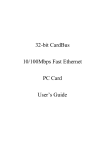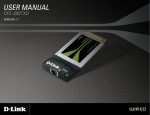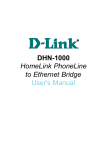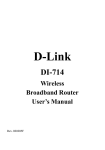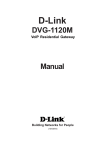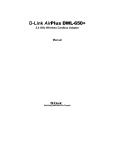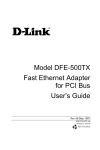Download D-Link DGE-660TD
Transcript
D-Link DGE-660TD Gigabit CardBus Notebook Adapter Manual Rev. 01 (Oct. 2004) Contents Introduction ...................................................................................1 General Description ............................................................................................ 1 About Gigabit Ethernet .................................................................2 About Auto-negotiation ..................................................................3 LED Indicators ...............................................................................5 Summary of Features......................................................................5 Troubleshooting..............................................................................6 Confirming the Connection (LED Indicator) ......................................................... 6 Troubleshooting the Hardware Installation............................................................ 6 Verify Each Computers Identification .................................................................... 7 Verify Network Adapter Installation ..................................................................... 7 Verify Cable Connections ................................................................................... 8 Diagnostics and Checking Communications ............................................................ 8 Pinging your DGE-660TD Card ............................................................................ 9 Windows 98SE/Me Network Component Configuration ....................10 Using File And Printer Sharing ............................................................................ 12 Enabling File Sharing ........................................................................................... 12 Enabling Printers Sharing ................................................................................... 14 Windows XP/2000 Network Component Configuration .....................15 Networking Basics ..........................................................................18 Computer Identification ....................................................................................... 18 Sharing Files ...................................................................................................... 20 Sharing Printers .................................................................................................. 24 How to Install TCP/IP ............................................................................................. 29 Configuring a Dynamic IP Address ....................................................................... 30 Configuring a Static IP Address .......................................................................... 33 Checking the TCP/IP Address ............................................................................ 36 Checking the Connection by Pinging .................................................................. 38 Specifications ........................................................................................................ 39 Contacting Technical Support ................................................................................. 41 Warranty ................................................................................................................. 42 Introduction Thank you for choosing the D-Link DGE-660TD, the value leader among Fast Ethernet/Gigabit Ethernet adapters for notebook PCs. This chapter provides a general description of DGE-660TD features, with a summary of features at the end of the chapter. Installation instructions are provided in Chapters 2 and 3. General Description The D-Link DGE-660TD Gigabit Cardbus PC Card for notebook PCs is a credit-card sized Gigabit adapter for connecting a notebook PC to an Ethernet, Fast Ethernet, or Gigabit network. The notebook PC must be equipped with a Type II Cardbus compliant slot. NOTE: The terms "PC Card" is used throughout this manual to refer to those objects as defined in the PCMCIA / PC Card standards published by Personal Computer Memory Card Industry Association (PCMCIA). The term “slot,” as used in this manual, is synonymous with “socket” where the standards use the latter term in reference to the physical receptacles of a host notebook computer, for insertion/connection of PC Cards. More information on the standards is available from PCMCIA’s www server at http://www.pc-card.com. The D-Link DGE-660TD automatically detects the parameters of its Ethernet environment, and automatically negotiates and determines its own speed and duplex settings as required for maximum performance within the environment. (The auto-negotiation function is effective only when the DGE-660TD is connected to the network by a device (switch or hub) that also has autonegotiation functionality.) Inside its compact case, the D-Link DGE-660TD holds an Ethernet controller, network processing interface, a 68-pin PC Card Standard front-end plug, which connects to the notebook PC, and a direct port for connecting a RJ-45 network -1 - cable. The DGE-660TD requires no pre-installation setup -- simply insert its front end into the notebook PC's PC-Card slot. The DGE-660TD is supplied with an RJ-45 receptacle, which receives the network cable. The direct port features full LED display for linkage and activity states, speed, transmitting and receiving data, and carrier detection. About Gigabit Ethernet Gigabit Ethernet is a network technology specified by IEEE Standard 802.3ab. It extends the traditional 100Mbps (100 megabit/sec) Fast Ethernet technology to achieve 1000Mbps (1000 megabit/sec) transmission and reception. Because Gigabit Ethernet retains the traditional Ethernet CSMA/CD (Carrier Sense, Multiple Access, and Collision Detect) protocol, it remains wholly compatible with 100Mbps Ethernet while providing a tenfold increase in network capacity. The DGE-660TD provides full-duplex 1000Base-T operation (in Category 5 twisted-pair cable environments utilizing all 4 pair). To provide for traditional 10 or 100Mbps Ethernet operation in twisted-pair cable environments, the DGE-660TD also offers 10 or 100Mbps Ethernet operation, in full-duplex and half-duplex modes. The DGE-660TD's auto-negotiation capability provides for automatic selection of the best operation mode. -2- About Auto-negotiation The basic idea of auto-negotiation can be understood by reflecting for a moment on the familiar process of making a dialup connection between two modems. You have probably heard some exchanges between your local modem and a modem at the other end of a telephone line. (These exchanges are ordinarily played out through a speaker in your local modem). As irritating as those few seconds of noise may be, they do let you know that your modem and the remote modem are on the job, preparing for your intended communication with the remote computer. The preparatory work of the two modems during those few seconds before you see the “connect” message is to negotiate the best data communication scheme that is supported by both modems, and to decide which is suitable for the quality of the telephone-line connection between them. The parameters to be settled between the two modems include best baud rate, compression method, and error correction method. When the two modems have tested the phone-line quality and have switched to the combination of parameters, which will provide the best data communication, then you are given the “connect” message which signals the end of the inter-modem negotiation and the beginning of your intended communication with the remote computer. Auto-negotiation between devices within an Ethernet LAN is similar in concept, but much briefer. The two devices involved in the auto-negotiation will be your DGE-660TD and the switch or hub through which it is connected into the LAN. (Switches ordinarily provide for auto-negotiation; traditional hubs do not.) The parameters to be negotiated between the DGE-660TD and its supporting switch or hub include speed (1000Mbps = Gigabit Ethernet, or 100Mbps = Fast Ethernet) and duplex mode (half-duplex or full-duplex). -3- Startup communication between the two devices occurs when both devices are operating, the cable connection between them is good, and the connected notebook PC's network software is loaded. As soon as those conditions are satisfied, the preparatory process of auto-negotiation between the DGE-660TD and its supporting device begins and proceeds automatically. If the supporting switch or hub has auto-negotiation functionality, then it and the DGE-660TD exchange a series of messages in which each device signals its capabilities and listens for corresponding information about the other. The auto-negotiation process requires only a few milliseconds, and the two devices select the best communication parameters supported by both devices. If the supporting device does not have auto-negotiation functionality, then its monotone (single capability) message will be recognized by the DGE-660TD’s auto-negotiation facility, and the DGE-660TD will simply switch to the one of its own capabilities that matches that of the supporting device. Once the auto-negotiation is completed, the line is ready, and it will provide an optimal data channel between the DGE-660TD and the supporting device. The line will remain ready without further auto-negotiation action until the link is broken. Auto-negotiation then reoccurs at any time that the link is restored, again making the line ready for optimal data communications. Minimum System Requirement: Your computer notebook must support: Pentium 150MHz or Faster 64MB RAM 32MB Free Hard Drive Space One Available CardBus Slot CD-ROM Drive -4- LED Indicators The DGE-660TD features 2 LED indicators: 1. Link/Activity (Link/ACT) This indicator lights green when the RJ-45 port is connected to an Ethernet network, if the indicator is blinking green it is transmitting/receiving data to/from the Ethernet network. 2. Speed Indicator (100Mbps/Amber; 100Mbps/Green; 10Mbps / Off) The indicator lights green when the port is connected to a 1000Mbps Gigabit Ethernet Network and the indicator lights amber when the port is connected to a 100Mbps Fast Ethernet Network. Otherwise, this indicator remains off when the port is connected to a 10Mbps Ethernet Network. Summary of Features Features of Model DGE-660TD Gigabit Cardbus PC Card: Complies with IEEE 802.3 10BASE-T Ethernet standard Complies with IEEE 802.3u 100BASE-TX Fast Ethernet standard Complies with IEEE 802.3ab 1000BASE-T Gigabit Ethernet standard Complies with ANSI / IEEE 802.3 Auto-Negitiation standard Complies with 32-bit CardBus Standard Supports Crossover Detection & Auto-Correction Built-in Transmit/Receive FIFO data buffer (8K/64K) No manual setup switches -- automatically configured by software Low power consumption Supported driver list: Microsoft Windows XP Microsoft Windows 2000 Microsoft Windows Me Microsoft Windows 98SE Microsoft Network Client for DOS (NDIS 2 driver) NetWare Client for DOS (ODI driver) -5- Troubleshooting Confirming the Connection (LED Indicator) When the notebook computer is powered “ON,” and the DGE-660TD is inserted into an open slot connector, please check the following items if your LED light is not “ON.” When all items are working, your DGE-660TD’s direct port LED light should light up green (“linkage” state.) 1. Make sure that your Ethernet Cat5 cable is in good working order. 2. Make sure that your hub or switch is powered “ON” and is functioning properly. 3. If the LED remains dark without any apparent cause, check the “Device Manager.” If there is an exclamation point next to the DGE-660TD, then double-click to open. A message indicating the error will appear. 4. After verifying that the DGE-660TD has been installed correctly, check steps 1 and 2 again. If you continue to encounter a problem, please call D-Link Technical Support for assistance. Troubleshooting the Hardware Installation If you experience any problems with the hardware installation, first ascertain that all network cable connections are firm, that the proper grade of cable is used for the network connection, and that the cable makeup is correct (straight without un-needed crossovers in the connector wiring). Check that the supporting hub is powered-on and operating normally, and that the hub is properly qualified (under 100Base-TX and/or 1000Base-T standards). - 6- Verify Each Computers Identification If more than one computer on your network has the same “Computer name,” communications may be negatively affected. Also, each computer must have the same “Workgroup” name to communicate properly. Verify Network Adapter Installation If your Network Adapter is not installed, including the Network System Software or Device drivers, your network will not function properly. Use these steps to verify that your Network Adapter is properly installed. 1. Double-Click the “System” icon in the Control Panel. 2. Click the “Device Manager” tab on top of the “System Properties” dialog box. 3. Double-Click “Network Adapters” if you do not see any items branching out. You should see “D-Link DGE-660TD Cardbus PC Card” branching out after double-clicking “Network Adapters.” If you do not see any items branching out after double-clicking “Network Adapters,” your Network Adapter has not been properly installed. Start at the beginning of the “Quick Install Guide.” If you see symbols such as yellow exclamation point or red “X” over the icon adjacent to “D-Link DGE-660TD Cardbus PC Card,” your card is not installed properly or may have a problem. Double-click the “D-Link DGE-660TD Cardbus PC Card” and read the explanation of the problem. This information will be helpful if you require technical support from D-Link. -7- Verify Cable Connections Check to see that the computer you are troubleshooting is properly connected. Each computer must be connected from its DGE-660TD with Category 5 cables. Examine the network cables and ensure that none have been walked-on, rolled over by chairs, caught in doors, or damaged. Additionally, make note of and alleviate any possible electromagnetic interference that may be affecting your network. Your network cables can be plugged into any port on your hub except the “Uplink” port. The “Uplink” port is only used when connecting your hub to another hub or switch. Diagnostics and Checking Communications Included on the CD-ROM is a “DGE-660TD PCMCIA Adapter Driver Program.” It is a diagnostic program that will help you determine if any faults exist in your DGE-660TD Network Adapters or connection. 1. Restart your computer in MS-DOS mode. (Click “Start,” then “Shut Down…,” and finally, select “Restart the computer in MS-DOS mode.”) 2. Insert the CD-ROM that came with your DGE-660TD Cardbus PC Card into your CD-ROM drive. (e.g., D:\) 3. Type D:\DIAG.EXE at the MS-DOS prompt and press “Enter” to start the D-Link Diagnostic Program. 4. Read and follow the instructions on the screen. (Press the F1 key for additional help.) 5. “Adapter Basic Diagnostic” will determine if any problems exist with DGE-660TD. 6. “Network Diagnostic” will determine if problems exist with your network or connections. To use “Network Diagnostic,” please run the program on both computers in MS-DOS Mode. If you encounter any problems, please contact D-Link technical support. -8- Pinging your DGE-660TD Card Follow these steps to Ping a device: Ping is the acronym for Packet Internet Groper (PING), a utility to determine if a specific IP address is accessible. It works by sending a packet to the specified address and waiting for a reply. Ping is primarily used to troubleshoot Internet connections. By sending out a ping, you are verifying that a specific computer is available. Since all computers on the network must have a unique IP address, getting a reply means that a computer is on the network and it can communicate. If you cannot ping another computer, then there is probably a problem with the hardware. Check the cabling and adapter installation. If you are unable to network, even when you receive a reply to your ping, it is probably a software configuration issue. Verify that all the settings are correct. Start MS-DOS Prompt. Type in following: ping:xxx.xxx.xx.xx, where xxx.xxx.xx.xx is the IP address to be pinged (i.e. 192.152.81.85). In this case, computer A is pinging its own IP address. A successful ping will show four replies. -9- Windows 98SE/Me Network Component Configuration Once the driver has been installed, you must make some changes to your network settings. Click Start > Settings > Control Panel > Network and make sure that you have all the following components installed. • Client for Microsoft Networks • D-Link DGE-660TD • NetBEUI • TCP/IP If any components are missing, click the Add button to add them. Microsoft includes all of these protocols in Windows. After you click Add, highlight the component you need, click Add, highlight Microsoft, and then double-click on the item you want to add. If you are using Windows 98SE, enable the File and Printer Sharing to make your computer visible on the network. Click the Identification tab. Type the name of your computer in the computer name box. Make up a name that is unique among the computer names on your network. Type the name of your workgroup in the workgroup box. The name you type should be the same workgroup name in use by all of the other PCs on the network. If one computer on your network has a different workgroup name than the others, that computer will not be shown in the same workgroup view. - 10 - Click the Access Control tab. Make sure that Shared-level access control is selected. If connecting to a NetWare server, share level can be set to User-level access control. When finished, remove all disks from your computer and restart your computer to activate the new device and new changes to network configuration. Once the computer has restarted and Windows has booted up, a Logon window will appear requiring you to enter a username and password. Make up a username and password, enter them, and click OK. Do not click the Cancel button, or you will not be able to log onto the network. - 11 - When you are at the Windows 98SE desktop, double-click the Network Neighborhood icon. You should see the names of the other PCs on the network that have enabled file and printer sharing. Using File And Printer Sharing Click Start > Settings> Control Panel. Double-click Network. Click the Configuration tab, followed by the File and Printer Sharing button. The File and Printer Sharing window will appear. If you would like others to be able to access the files on your computer’s hard drive, select I want to be able to give others access to my files. If you would like to share your printer with other users on the network, select I want to be able to allow others to print to my printer. Click OK. File and Printer Sharing for Microsoft Networks should now appear on the list of installed components. Click OK. When asked to restart your computer, choose to do so. Enabling File Sharing Double-click My Computer. A window of available disk drives will appear. Right-click once the drive or folder that you want to make available to other users. - 12 - Click Sharing, and then click Share As. In the Share Name box, enter a name for the drive or folder you are sharing, (eg: C-Drive, CD-ROM, John, etc.). Next, decide on the access type that you want to give other users. Read-Only access lets other users view the files on your PC. Full access lets users create, change, or delete files on your PC. Depends on Password lets users have Read-Only and/or Full access, depending on the password that you decide to give them. Use your mouse to select the access type that you want other users to have. If you want to assign an access password(s), type them into the Password box(es). If you are sharing a cable modem or DSL broadband connection that you will be using to access the Internet, you should protect all of your shared drives and printers with private passwords. When finished, click Apply, followed by OK. - 13 - Enabling Printer Sharing Click Start > Settings> Printers. A window of available printers will appear. Right-click the printer that you want to share with other users. Click Sharing, and then click Share As. In the Share Name box, give a name to the printer you are about to share (Jack's HP4, for example). If you want to assign a password to the printer so only certain users can access it, type a password in the Password box. When you are done, click Apply, followed by OK. Your printer(s) are now shared. - 14 - Windows XP/2000 Network Component Configuration This section includes instructions specific to the Windows 2000 operating system. However, Windows XP instructions are very similar. For additional information regarding this section, please consult your Windows documentation provided my Microsoft. Go to Start >Settings >Control Panel >Network and Dial-up Connections. Double-click the Local Area Connection icon; the following figure will appear. Click the Properties button. Make sure the following components are installed. • Client for Microsoft Networks • File and Printer Sharing for Microsoft Networks • NetBEUI Protocol • Internet Protocol (TCP/IP) If any components listed above are missing, click the Install button to add them manually. Click Close to exit. - 15 - Go to Start > Settings> Control Panel > System. Open the Network Identification tab and click the Properties button. Type the name of your computer in the computer name box. Make up a name that is unique among the computers names on your network. - 16 - Type the name of your workgroup in the workgroup box. The name you type should be the same workgroup name in use by all of the other PCs on the network. When finished, remove all disks from your computer and restart your computer to activate the new device and with new configuration changes. Once the computer has restarted and Windows 2000 has booted up, a Logon window will appear requiring you to enter a username and password. Make up a username and password, enter them, and click OK. Do not click the Cancel button, or you will not be able to log onto the network. When you are at the Windows 2000 desktop, double-click My Network Places or Computers Near Me. You should see the names of the other PCs on the network that have enabled file and printer sharing. Refer to the Windows 98SE/Me Network Component Configuration section for instructions on setting up File and Print sharing. - 17 - Networking Basics You may have had some ideas about how to use your new network prior to installing this product - sharing files, printing from a computer on the network, or accessing the Internet on multiple computers with one connection. This section will help you get started on those ideas or even give you some new ones. However, this section is not intended to be a comprehensive guide to networking, it is just an outline of a few networking basics. If you are interested in learning more about networking please visit our website: http://www.dlink.com D-Link is one of the largest manufacturers of Ethernet products in the world. D-Link’s technological expertise and dedication to providing quality products at a low price makes D-Link a good place to watch for the newest in networking innovations. Or, you may want to get the newest drivers available for your Network Adapters. Computer Identification If you had previously given your Windows 98SE computers names or if you are using Windows 98SE, you may need to verify that each computer has a unique name and common workgroup name. A. On your Desktop, right-click the icon "Network Places" and select "Properties" from the context menu. - 18 - B. Click the "Identification" tab on the top of the dialog box. C. Type a unique, identifying name for this particular computer in the "Computer name:" box. This will be the name that other computers on your network will use to communicate with this computer. Each computer’s name must be unique on a particular network or confusion will result. (The computer’s name should be 15 or fewer characters with no spaces.) D. Type the workgroup name this computer will be a part of in the "Workgroup:" box. All of the computers on your network should have an identical Workgroup name. E. The "Computer Description:" box is optional. You may enter a description that will help you identify this computer on your network. Then click "Close." F. Repeat this process for each computer on your network to ensure that they all have a unique "Computer Name" and identical “workgroup." -19 - Sharing Files With your computers connected together on a network, you may now open and save files on another computer. You will be able to specify particular folders or disk drives to "share" and even password protect them. The steps below will enable you to share specific files and folders with other computers on your network. A. On your Desktop, right-click the icon "Network Places" and select "Properties" from the context menu. B. This dialog box is what you will use to configure most of your computer network settings. It is also available through the "Network" icon in the Control Panel. - 20 - C. Click the "File and Print Sharing" button. D. Click to place a check mark next to "I want to be able to give others access to my files." E. Click "OK" on the "File and Print Sharing" dialog box. F. Click "OK" on the "Network" dialog box. G. Provide the Windows 98SE installation CD or diskette(s) if prompted or direct Windows to the proper location of the installation files. Reboot if prompted. H. You will now be able to identify a particular folder or disk drive to share. You may want to share a folder that both you and a colleague/family member need to access occasionally. Or, maybe you want to share a CDROM drive so your other computer that does not have one can read CD’s. Both processes are the same. Only the disk drives and folders that you specifically identify as shared will be accessible to other computers on your network. I. Find the disk drive or folder you want to share using Windows Explorer or the "My Computer" icon on your desktop. - 21 - J. Right-click on the disk drive or folder icon and select "Sharing." K. Select "Share As:" to set the parameters for sharing this particular disk drive or folder. L. The "Share Name:" box is used to identify the disk drive or folder you are sharing to other computers on the network. You can give it any name you - 22 - wish. However, a specific identification may help as more resources on your network are shared. M. The "Comment:" box is optional. You can use this box to further describe the disk drive or folder for others on the network. N. "Access Type:" allows you to designate how much others on the network can do with this disk drive or folder. "Read-Only" allows others only to look at or open the files on the disk drive or in the folder. "Full" allows others to read, write, open, save, copy, move, and delete files on the disk or in the folder. "Depends on Password" gives other computers access conditional upon the password they provide. O. "Passwords:" allow you to apply a level of security to your shared disk drives and folders. Another computer (user) will be required to enter the password you designate here before accessing the disk drive or folder. Two passwords are used to give two levels of security (or access) to others on the network using the "Depends on Password" setting. Leaving the "Password" boxes empty gives everyone on the network access to the disk drive or folder. P. Click "OK" to continue. You will be prompted to enter the password(s) you provided for verification. Retype the password(s) just as you entered them the first time. Q. You may now access this disk drive or folder from another computer on your network. Do so by double-clicking the "My Network Places" icon on your desktop or inside Windows Explorer. R. Navigate to the computer with the shared disk drive or folder (recognized by the "Computer Name" you provided), and double-click. You should now see the disk drive or folder; double-click on the drive or folder. If you specified a password when sharing this disk drive or folder, you will be prompted for the password. S. You can access a disk drive or folder shared over the network from most Windows applications. To make this process easier, Windows allows you - 23 - to map these disk drives and folders to a drive letter on another computer. For example, on a computer where you are accessing a shared folder from another computer, inside Windows Explorer right-click and select "Map Network Drive.” You will then be able to assign an available drive letter. Checking "Reconnect at logon" allows Windows to map this network drive each time you start your computer. Sharing Printers "Sharing" a printer connected to one computer with other computers on your network can be very convenient, allowing you to print from any computer on the network. The steps below will enable you to print with other computers on your network. A. On your Desktop, right-click the icon "Network Places" and select "Properties" from the context menu. B. Click the "File and Print Sharing" button. - 24 - C. Click to place a check mark next to "I want to be able to allow others to print to my printer(s)." D. Click "OK" on the "File and Print Sharing" dialog box. E. Click "OK" on the "Network" dialog box. F. You may now share any installed printers connected to this computer with other computers on your network. - 25 - Go to START>SETTINGS>PRINTERS Right click on the printer you want to share with others on the network and select "Sharing." G. Click "Share As:" and provide a "Share Name:" to identify the printer to other computers on the network. "Comment:" and "Password:" are optional. Then click "OK." For a computer to access a Network Printer, the device driver or software for that printer must be installed and pointed to the proper location of the printer. This is done much the same way you installed the printer on the computer it is connected to. H. Go to a computer that does not have the printer connected to it. From the "Start" button on the Task Bar select "Settings" and then "Printers." I. Double click the "Add Printer" icon. J. The "Add Printer Wizard" will appear. Click "Next." K. Choose "Network printer" and click "Next." L. Now you will identify the location of the Network Printer. If you know the name of the computer and the share name of the printer, you can type it into - 26 - the "Network path or queue name:" box. However, it is easier to click the "Browse" button and navigate to the location of the printer. Click "OK" when you have selected the desired printer. Finish the installation by continuing the "Add Printer Wizard" normally. M. You may now use the Network Printer as if it was connected directly. Note: the computer that the printer is connected to must be “on” to use the printer. If you find this inconvenient, devices known as Network Print Servers are available from D-Link including the DP-301 and DP-101P. A Network Print Server would allow you to directly connect your printer to your network without worrying about which computer is “on.” - 27 - Go to START > SETTINGS > CONTROL PANEL Double Click on “Network” - 28 - How to Install TCP/IP Select “D-Link DGE-660TD Cardbus PC Card.” Click on “Add.” Select “Protocol.” Click “Add.” Select “Microsoft.” - 29 - Click “OK.” Now the “TCP/IP for D-Link DGE-660TD Cardbus PC Card” is available. The TCP/IP Installation is complete. Configuring a Dynamic IP Address When the drivers are installed, the default setting is set to obtain an IP dynamically through a DHCP server. If you need to check or change the settings, then do the following: Go to START > SETTINGS > CONTROL PANEL - 30 - Double Click on “Network” Highlight “TCP/IP.” Click on “Properties.” - 31 - NOTE: If TCP/IP is not present, see the previous section: “How to Install TCP/IP.” When the TCP/IP window opens, choose the “IP Address” tab. Select “Obtain an IP Address Automatically.” Click “OK.” When the network properties window comes back up, click “OK.” Windows will ask you to reboot. Click “Yes.” You have completed the configuration of the Dynamic IP Address. - 32 - Configuring a Static IP Address Go to START > SETTINGS > CONTROL PANEL Double Click on “Network” - 33 - Highlight “TCP/IP.” Scroll down if you cannot see it. Click on “Properties.” NOTE: If TCP/IP is not present, please see: “How to Install TCP/IP.” When the “TCP/IP Properties” window opens, choose the “IP Address” tab. Select “Specify an IP address.” - 34 - Enter an IP address into the empty field. Suggested IP Range is 192.168.0.2 to 192.168.0.254. NOTE: IP Addresses must be signed sequentially to each computer. Suggested Subnet Mask of 255.255.255.0. Click “OK.” When the “Network Properties” window comes back up click “OK.” Insert Windows CD if prompted. Windows will ask you to reboot. Click “Yes.” - 35 - Checking the TCP/IP Address 1 Go to Start > Type “winipcfg” in the “OPEN” box. Click “OK.” Click "OK." The IP Configuration screen will be displayed. The IP address will be displayed in the IP Address box. - 36 - Click on “More Info” to display additional IP information. - 37 - Checking the Connection by Pinging Click "OK" to get to a DOS prompt. Type "ping 192.168.0.1," which is the IP address of the Gateway in this case, and hit the "Enter" key. - 38 - A successful ping will show four replies. Specifications Standards: • IEEE 802.3 10Base-T Ethernet • IEEE 802.3u 100Base-TX Fast Ethernet • IEEE 802.3ab 1000Base-T Gigabit Ethernet • ANSI/IEEE 802.3 NWay Auto-Negotiation • PCMCIA 2.x • 32-bit Cardbus Network Media: • Ethernet: UTP Cat3, 4, 5 EIA/TIA-568 100-ohm • Fast Ethernet: UTP Cat5, EIA/TIA-568 100-ohm Protocol: • CSMA/CD Host Interface: • 32-bit Cardbus Diagnostic LEDs: • Link/Activity • Speed (Green: 1000M; Amber : 100M; Off : 10M) - 39 - Network Data Transfer Rate: • Ethernet: 10Mbps (Half-duplex) • Ethernet: 20 Mbps (Full-duplex) • Fast Ethernet: 100Mbps (Half-duplex) • Fast Ethernet: 200Mbps (Full-duplex) • Gigabit Ethernet: 2000Mbps (Full-duplex) Temperature: • Operating: -10~50 °C (14~122°F) • Storage: -10~70 °C (14~158°F) Humidity: • Operating: 10%~90% RH • Storage: 5%~90% RG Driver Support: • Microsoft Windows XP • Microsoft Windows 2000 • Microsoft Windows Me • Microsoft Windows 98SE • Microsoft Network Client for DOS (NDIS 2 driver) • NetWare Client for DOS (ODI driver) Emission: • FCC Class B • CE mark Class B • VCCI-B *Check http://www.dlink.com for newest releases of drivers. Technical Support You can find software updates and user documentation on the D-Link website. D-Link provides free technical support for customers within the United States and within Canada for the duration of the warranty period on this product. U.S. and Canadian customers can contact D-Link technical support through our website, or by phone. Tech Support for customers within the United States: D-Link Technical Support over the Telephone: (877) 453-5465 24 hours a day,seven days a week D-Link Technical Support over the Internet: http://support.dlink.com email:[email protected] Tech Support for customers within Canada: D-Link Technical Support over the Telephone: (800) 361-5265 Monday to Friday 7:30am to 12:00am EST D-Link Technical Support over the Internet: http://support.dlink.ca email:[email protected] - 40 - Subject to the terms and conditions set forth herein, D-Link Systems, Inc. (“D-Link”) provides this Limited warranty: • • Only to the person or entity that originally purchased the product from D-Link or its authorized reseller or distributor, and Only for products purchased and delivered within the fifty states of the United States, the District of Columbia, U.S. Possessions or Protectorates, U.S. Military Installations, or addresses with an APO or FPO. Limited Warranty: D-Link warrants that the hardware portion of the D-Link product described below (“Hardware”) will be free from material defects in workmanship and materials from the date of original retail purchase of the product, for the period set forth below (“Warranty Period”), except as otherwise stated herein. • • • Hardware (excluding power supplies and fans): Two (2) Years Power supplies and fans: One (1) Year Spare parts and spare kits: Ninety (90) days D-Link’s sole obligation shall be to repair or replace the defective Hardware during the Warranty Period at no charge to the original owner or to refund the actual purchase price paid, at D-Link’s sole discretion. Any repair or replacement will be rendered by D-Link at an Authorized D-Link Service Office. The replacement hardware need not be new or have an identical make, model or part. D-Link may in its sole discretion replace the defective Hardware or any part thereof with any reconditioned product that D-Link reasonably determines is substantially equivalent (or superior) in all material respects to the defective Hardware. Repaired or replacement hardware will be warranted for the remainder of the original Warranty Period from the date of original retail purchase. If a material defect is incapable of correction, or if D-Link determines in its sole discretion that it is not practical to repair or replace the defective Hardware, the actual price paid by the original purchaser for the defective Hardware will be refunded by D-Link upon return to D-Link of the defective Hardware. All Hardware or part thereof that is replaced by D-Link, or for which the purchase price is refunded, shall become the property of D-Link upon replacement or refund. Limited Software Warranty: D-Link warrants that the software portion of the product (“Software”) will substantially conform to D-Link’s then current functional specifications for the Software, as set forth in the applicable documentation, from the date of original retail purchase of the Software for a period of ninety (90) days (“Software Warranty Period”), provided that the Software is properly installed on approved hardware and operated as contemplated in its documentation. D-Link further warrants that, during the Software Warranty Period, the magnetic media on which D-Link delivers the Software will be free of physical defects. D-Link’s sole obligation shall be to replace the non-conforming Software (or defective media) with software that substantially conforms to D-Link’s functional specifications for the Software or to refund the portion of the actual purchase price paid that is attributable to the Software, at D-Link’s sole discretion. Except as otherwise agreed by D-Link in writing, the replacement Software is provided only to the original licensee, and is subject to the terms and conditions of the license granted by D-Link for the Software. Replacement Software will be warranted for the remainder of the original Warranty Period from the date of original retail purchase. If a material non-conformance is incapable of correction, or if D-Link determines in its sole discretion that it is not practical to replace the non-conforming Software, the price paid by the original licensee for the non-conforming Software will be refunded by D-Link; provided that the non-conforming Software (and all copies thereof) is first returned to D-Link. The license granted respecting any Software for which a refund is given automatically terminates. Non-Applicability of Warranty: The Limited Warranty provided hereunder for Hardware and Software portions of D-Link's products will not be applied to and does not cover any refurbished product and any product purchased through the inventory clearance or liquidation sale or other sales in which D-Link, the sellers, or the liquidators expressly disclaim their warranty obligation pertaining to the product and in that case, the product is being sold "As-Is" without any warranty whatsoever including, without limitation, the Limited Warranty as described herein, notwithstanding anything stated herein to the contrary. Submitting A Claim: The customer shall return the product to the original purchase point based on its return policy. In case the return policy period has expired and the product is within warranty, the customer shall submit a claim to D-Link as outlined below: • The customer must submit with the product as part of the claim a written description of the Hardware defect or Software nonconformance in sufficient detail to allow D-Link to confirm the same. • The customer must obtain a Return Material Authorization (“RMA”) number from the Authorized D-Link Service Office and, if requested, provide written proof of purchase of the product (such as a copy of the dated purchase invoice for the product) before the warranty service is provided. • After an RMA number is issued, the defective product must be packaged securely in the original or other suitable shipping package to ensure that it will not be damaged in transit, and the RMA number must be prominently marked on the outside of the package. Do not include any manuals or accessories in the shipping package. D-Link will only replace the defective portion of the product and will not ship back any accessories. • The customer is responsible for all in-bound shipping charges to D-Link. No Cash on Delivery (“COD”) is allowed. Products sent COD will either be rejected by D-Link or become the property of D-Link. Products shall be fully insured by the customer and shipped to D-Link Systems, Inc., 17595 Mt. Herrmann, Fountain Valley, CA 92708. D-Link will not be held responsible for any packages that are lost in transit to D-Link. The repaired or replaced packages will be shipped to the customer via UPS Ground or any common carrier selected by D-Link, with shipping charges prepaid. Expedited shipping is available if shipping charges are prepaid by the customer and upon request. D-Link may reject or return any product that is not packaged and shipped in strict compliance with the foregoing requirements, or for which an RMA number is not visible from the outside of the package. The product owner agrees to pay D-Link’s reasonable handling and return shipping charges for any product that is not packaged and shipped in accordance with the foregoing requirements, or that is determined by D-Link not to be defective or non-conforming. What Is Not Covered: The Limited Warranty provided herein by D-Link does not cover: Products that, in D-Link’s judgment, have been subjected to abuse, accident, alteration, modification, tampering, negligence, misuse, faulty installation, lack of reasonable care, repair or service in any way that is not contemplated in the documentation for the product, or if the model or serial number has been altered, tampered with, defaced or removed; Initial installation, installation and removal of the product for repair, and shipping costs; Operational adjustments covered in the operating manual for the product, and normal maintenance; Damage that occurs in shipment, due to act of God, failures due to power surge, and cosmetic damage; Any hardware, software, firmware or other products or services provided by anyone other than D-Link; and Products that have been purchased from inventory clearance or liquidation sales or other sales in which D-Link, the sellers, or the liquidators expressly disclaim their warranty obligation pertaining to the product. Repair by anyone other than D-Link or an Authorized D-Link Service Office will void this Warranty. Disclaimer of Other Warranties: EXCEPT FOR THE LIMITED WARRANTY SPECIFIED HEREIN, THE PRODUCT IS PROVIDED “AS-IS” WITHOUT ANY WARRANTY OF ANY KIND WHATSOEVER INCLUDING, WITHOUT LIMITATION, ANY WARRANTY OF MERCHANTABILITY, FITNESS FOR A PARTICULAR PURPOSE AND NON-INFRINGEMENT. IF ANY IMPLIED WARRANTY CANNOT BE DISCLAIMED IN ANY TERRITORY WHERE A PRODUCT IS SOLD, THE DURATION OF SUCH IMPLIED WARRANTY SHALL BE LIMITED TO NINETY (90) DAYS. EXCEPT AS EXPRESSLY COVERED UNDER THE LIMITED WARRANTY PROVIDED HEREIN, THE ENTIRE RISK AS TO THE QUALITY, SELECTION AND PERFORMANCE OF THE PRODUCT IS WITH THE PURCHASER OF THE PRODUCT. Limitation of Liability: TO THE MAXIMUM EXTENT PERMITTED BY LAW, D-LINK IS NOT LIABLE UNDER ANY CONTRACT, NEGLIGENCE, STRICT LIABILITY OR OTHER LEGAL OR EQUITABLE THEORY FOR ANY LOSS OF USE OF THE PRODUCT, INCONVENIENCE OR DAMAGES OF ANY CHARACTER, WHETHER DIRECT, SPECIAL, INCIDENTAL OR CONSEQUENTIAL (INCLUDING, BUT NOT LIMITED TO, DAMAGES FOR LOSS OF GOODWILL, LOSS OF REVENUE OR PROFIT, WORK STOPPAGE, COMPUTER FAILURE OR MALFUNCTION, FAILURE OF OTHER EQUIPMENT OR COMPUTER PROGRAMS TO WHICH D-LINK’S PRODUCT IS CONNECTED WITH, LOSS OF INFORMATION OR DATA CONTAINED IN, STORED ON, OR INTEGRATED WITH ANY PRODUCT RETURNED TO D-LINK FOR WARRANTY SERVICE) RESULTING FROM THE USE OF THE PRODUCT, RELATING TO WARRANTY SERVICE, OR ARISING OUT OF ANY BREACH OF THIS LIMITED WARRANTY, EVEN IF D-LINK HAS BEEN ADVISED OF THE POSSIBILITY OF SUCH DAMAGES. THE SOLE REMEDY FOR A BREACH OF THE FOREGOING LIMITED WARRANTY IS REPAIR, REPLACEMENT OR REFUND OF THE DEFECTIVE OR NON-CONFORMING PRODUCT. THE MAXIMUM LIABILITY OF D-LINK UNDER THIS WARRANTY IS LIMITED TO THE PURCHASE PRICE OF THE PRODUCT COVERED BY THE WARRANTY. THE FOREGOING EXPRESS WRITTEN WARRANTIES AND REMEDIES ARE EXCLUSIVE AND ARE IN LIEU OF ANY OTHER WARRANTIES OR REMEDIES, EXPRESS, IMPLIED OR STATUTORY Governing Law: This Limited Warranty shall be governed by the laws of the State of California. Some states do not allow exclusion or limitation of incidental or consequential damages, or limitations on how long an implied warranty lasts, so the foregoing limitations and exclusions may not apply. This limited warranty provides specific legal rights and the product owner may also have other rights which vary from state to state. Trademarks: D-Link is a registered trademark of D-Link Systems, Inc. Other trademarks or registered trademarks are the property of their respective manufacturers or owners. Copyright Statement: No part of this publication or documentation accompanying this product may be reproduced in any form or by any means or used to make any derivative such as translation, transformation, or adaptation without permission from D-Link Corporation/D-Link Systems, Inc., as stipulated by the United States Copyright Act of 1976 and any amendments thereto. Contents are subject to change without prior notice. Copyright© 2004 by D-Link Corporation/D-Link Systems, Inc. All rights reserved. CE Mark Warning: This is a Class B product. In a domestic environment, this product may cause radio interference, in which case the user may be required to take adequate measures. FCC Statement: This equipment has been tested and found to comply with the limits for a Class B digital device, pursuant to part 15 of the FCC Rules. These limits are designed to provide reasonable protection against harmful interference in a residential installation. This equipment generates, uses, and can radiate radio frequency energy and, if not installed and used in accordance with the instructions, may cause harmful interference to radio communication. However, there is no guarantee that interference will not occur in a particular installation. If this equipment does cause harmful interference to radio or television reception, which can be determined by turning the equipment off and on, the user is encouraged to try to correct the interference by one or more of the following measures: • • • • Reorient or relocate the receiving antenna. Increase the separation between the equipment and receiver. Connect the equipment into an outlet on a circuit different from that to which the receiver is connected. Consult the dealer or an experienced radio/TV technician for help. For detailed warranty information applicable to products purchased outside the United States, please contact the corresponding local D-Link office. Warranty Registration Register online your D-Link product at http://support.dlink.com/register/

















































